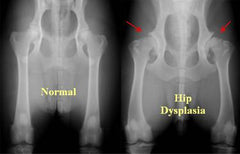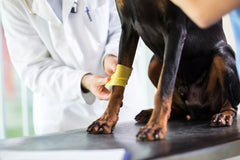Degenerative joint diseases¹ are common in dogs. These include arthritis, hip dysplasia, and bone cancer among others. Arthritis can be defined as inflammation of the joints caused by wear and tear of the cartilage that plays a vital role in reducing friction within the joints.
Arthritic changes usually include pain and swelling of affected joints, inability to climb stairs or get up, joint stiffness, limping, etc. These changes can start early in most dogs but go unnoticed until their senior years. If you have noticed any of these changes in your dog, read on.
These are the most common causes of joint pain.
- Ligament Damage
This results from injuries e.g. fractures that tear bone ligaments that help in joint stability. This is common in knee joints ensuing damage to the cranial cruciate ligament. The bones of the affected joint end up rubbing rub against each other leading to the wear and tear of the cartilage. Pain, joint swelling and stiffness usually follow. Early diagnosis and treatment with glucosamine for dogs supplements are pretty common.
- Bone Instability
Bone instability is seen in cases of hip and elbow dysplasia. These conditions are hereditary and are passed to puppies from their parents. It is commonly seen in puppies between 6 to 9 months old. Dysplasia occurs when the ball of the thigh bone does not fit into the cup of the acetabulum of the hip bone or when the cup is too big for the ball to fit. This causes constant banging of the bones against each other. Over time there is a breakdown of cartilage within the joint which causes friction, pain, swelling, and immobility. A surgical procedure is typically performed as soon as possible to prevent arthritic changes from taking place.
 Patella luxation is also another form of bone instability where the knee cap slides out of place. This also causes a lot of rubbing of bones against each other predisposing the animal to arthritis of the knee. Dogs appear not to put weight on the affected leg.
Patella luxation is also another form of bone instability where the knee cap slides out of place. This also causes a lot of rubbing of bones against each other predisposing the animal to arthritis of the knee. Dogs appear not to put weight on the affected leg.
- Osteochondrosis Dissecans
Osteochondrosis refers to abnormal growth and thickening of cartilage found on bone surfaces. Osteochondrosis dissecans occurs as a result of inflammation and separation of the abnormally developed cartilage from the bone due to lack of blood supply. Pieces of broken cartilage may get into the joint space which may lead to pain, lameness and joint stiffness.
This is mostly observed in medium to large breed dogs between 4 to 8 months old. Treatment includes surgical removal of the excess cartilage.
- Autoimmune Diseases
This refers to rheumatoid arthritis which occurs when the body’s immune system forms antibodies and attacks the joints. This causes inflammation and thickening of the synovial fluid which acts as a lubricant useful in preventing friction between joint during movement. With time the inflammation spreads to the cartilage causing it to wears off leading to arthritis.
 Rheumatoid arthritis affects all joints and is characterized by pain, joint stiffness, lameness, and swollen joints. Immune suppressants, food supplements, and steroids are prescribed in the treatment of this disorder.
Rheumatoid arthritis affects all joints and is characterized by pain, joint stiffness, lameness, and swollen joints. Immune suppressants, food supplements, and steroids are prescribed in the treatment of this disorder.
- Joint Infections
Osteomyelitis refers to the bacterial infection of the joint cavity. It occurs as a result of penetrating wounds, contamination of the joint cavity during surgery or when a bacteria localizes within the joint cavity from other parts of the body. If treatment is not performed timely, the cartilage becomes greatly damaged resulting in septic arthritis. Pain, lameness, and swelling of joints are observed in affected animals. Treatment involves draining the infected fluid and administering antibiotics.
In summary, it is very important to be observant of changes in your dog’s posture, especially for pups and senior dogs. This allows an early diagnosis to prevent further deterioration that could result in arthritis, which can be very expensive to treat. In most cases, it is also recommended that you start your dog on a high-quality joint supplement to support joints and bone structure.
No comments:
Post a Comment